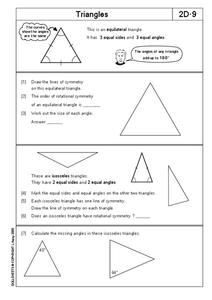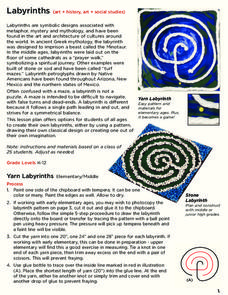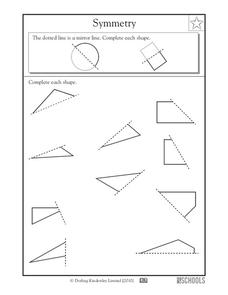Curated OER
Brain Train
A lengthy presentation on geometric reflections is here for your young geometers. Learners consider a shape, then must choose between four reflections to find the one that is a true vertical, horizontal, or diagonal reflection of the...
Curated OER
Visualizing and Naming Polygons
A really useful resource contains 116 slides covering basic geometric concepts related to 2-D or plane shapes. Shape properties, translations, reflections, congruence, symmetry, and grid work are all laid out in a comprehensive and...
Curated OER
Triangles
In this math worksheet, students answer 3 questions about an equilateral triangle. Students then answer 3 questions about isosceles triangles. Students then calculate missing angles on isosceles triangles.
Teachers Network
A World of Symmetry: Math-Geometry
Define and identify the three basic forms of symmetry translation, rotation, and glides with your class. They cut out and arrange paper pattern blocks to illustrate symmetry, create a Cartesian graph, and design a rug with a symmetrical...
Curated OER
Labyrinths
Whether studying metaphors or Greek mythology, this labyrinth project is a fantastic lesson plan to add to your unit. It includes two versions of the labyrinth; making it with yarn or stone. If your materials are limited, you can even...
Curated OER
Symmetrical Geometry Paintings
Here is a clever, cross-curricular lesson that combines art and geometry. Learners design a painting that uses geometrical shapes and is symmetrical. Sponge-shaped geometrical figures are used to design half a page and fold them to...
Curated OER
Simetria
Your Spanish students will see what symmetry looks like on a quadrilateral, triangle, and circle in this presentation. Large, bright shapes are displayed with lines of symmetry, followed by examples that do not show a line of...
Incredible Art Department
Notan Collages - "Expanding the Square"
Notan is a Japanese word that expresses the interaction between light and dark. Learners explore Notan while creating dimensional art pieces that examine positive and negative spaces. They'll discuss the art of Notan, create...
Curated OER
Sculpture in Balance
Learners discuss the difference betwen two-dimensional vs. three-dimensional art. In this art lesson, students discuss what symmetry or balance is in art and construct a symmetrical and an asymmetrical mobile.
Curated OER
Symmetry, Part 2
How can you tell if shapes are symmetrical? Fourth graders study 12 shapes, and draw lines down the middle of shapes that have symmetry. Once they are finished, they complete shapes that are missing their symmetrical sides. Some shapes...
Curated OER
Symmetry
Enhance your geometry lesson by working with shapes. Fourth graders follow lines of symmetry to complete ten shapes, most of them currently triangles. Have pupils color each half of their shapes to reinforce the idea of symmetry!
Curated OER
Bliss Butterflies Activity Sheet
In this life science activity, students examine the 4 stages of the butterfly's life cycle and color in the black line pictures. They read the difference between symmetrical and asymmetrical objects before they complete symmetrical...
Curated OER
Symmetry
Is this the line of symmetry? Scholars analyze 12 images to determine whether or not the dotted line in each reflects symmetry. There are three examples for them to reference before they start, so consider reviewing these together before...
Curated OER
Symmetry
Fold these shapes in half and you'll have perfectly equal sides. Kids explore symmetry by completing 16 abstract shapes which have been cut off at the line of symmetry. They draw the mirror image, using several examples as reference. An...
Curated OER
Symmetry
These symmetrical shapes are only half-completed, so scholars finish them by drawing the other side of the line of symmetry. Because your class won't recognize these abstract shapes, they will get authentic practice with this objective....
Curated OER
Symmetry
Where is the line of symmetry? Learners begin by drawing in a line to split three images evenly in half, using an example as reference. Encourage them to think about physically folding the picture to solidify this concept. Next, they do...
Curated OER
Symmetry
Do these dotted lines indicate symmetry? Some of them do, and scholars determine which ones in 12 different images. Because some of these are tricky, it may be helpful to have large versions of these shapes printed and cut out. This way,...
Curated OER
Dihedral Figures
Middle and high schoolers perform transformations. In this web based instructional activity, students explore dihedral figures. They use the web tools to translate, rotate, and reflect figures. Pupils identify lines of symmetry.
Curated OER
Crazy for Cubes: Art and Science
Learners discuss Sol LeWitt and conceptual art, then analyze the differences in expressing a concept through model-based inquiry and aesthetic art criticism. They develop a geometric, scientific, or mathematical concept, then create an...
Curated OER
Rotational Hex Designs
Learn about the Pennsylvania Dutch folk art, Rotational Hex Design. This image-rich presentation provides a comprehensive description of the origin and meaning behind these interesting totems. Instructions to create these symmetrical...
Curated OER
Principle of Art Balance
Reinforce a strong art vocabulary which can also apply to aspects of math and science. Kids read about various types of balance or symmetry found in art. They analyze three paintings based on vocabulary and read a how-to for creating...
Curated OER
Big Fleas Have Little Fleas
A benthic habitat hosts a vast collection of organisms and its structure influences the biodiversity. Middle-school marine biology explorers will discuss how corals impact structure, and therefore diversity, on the ocean floor. They draw...
Curated OER
Symmetry
A very clever marriage of social studies and math is offered in this presentation. Young mathematicians look at slides of a variety of flags of the world and try to find the line of symmetry in each. A clever way to practice symmetry!
Curated OER
Symmetrical Patterns
The class thinks about symmetry and patterns. They view several symmetrical patterns represented as dots with a mirror in between. They discuss which images are symmetrical and which are not, then color in dots to complete a few...

























